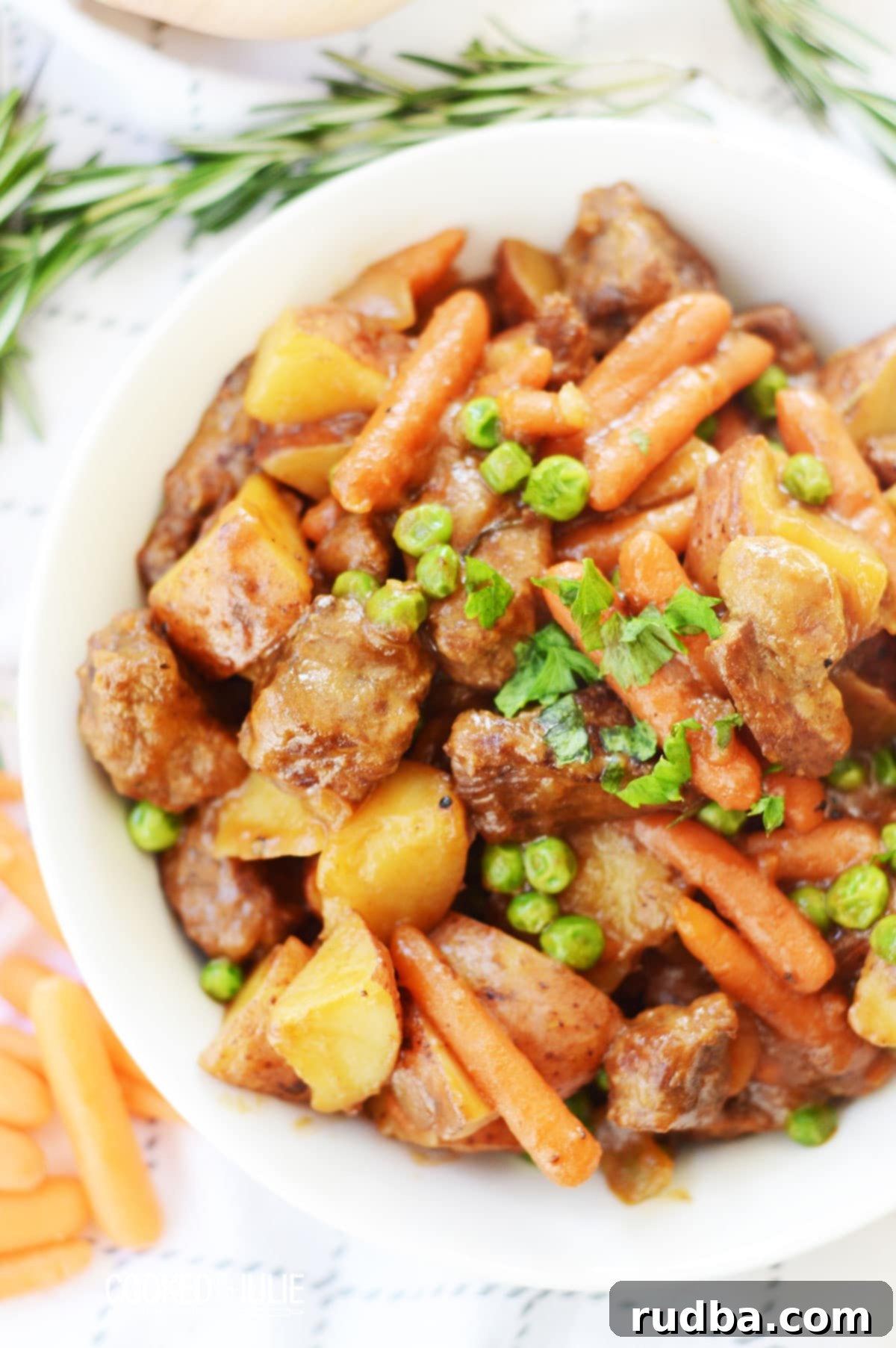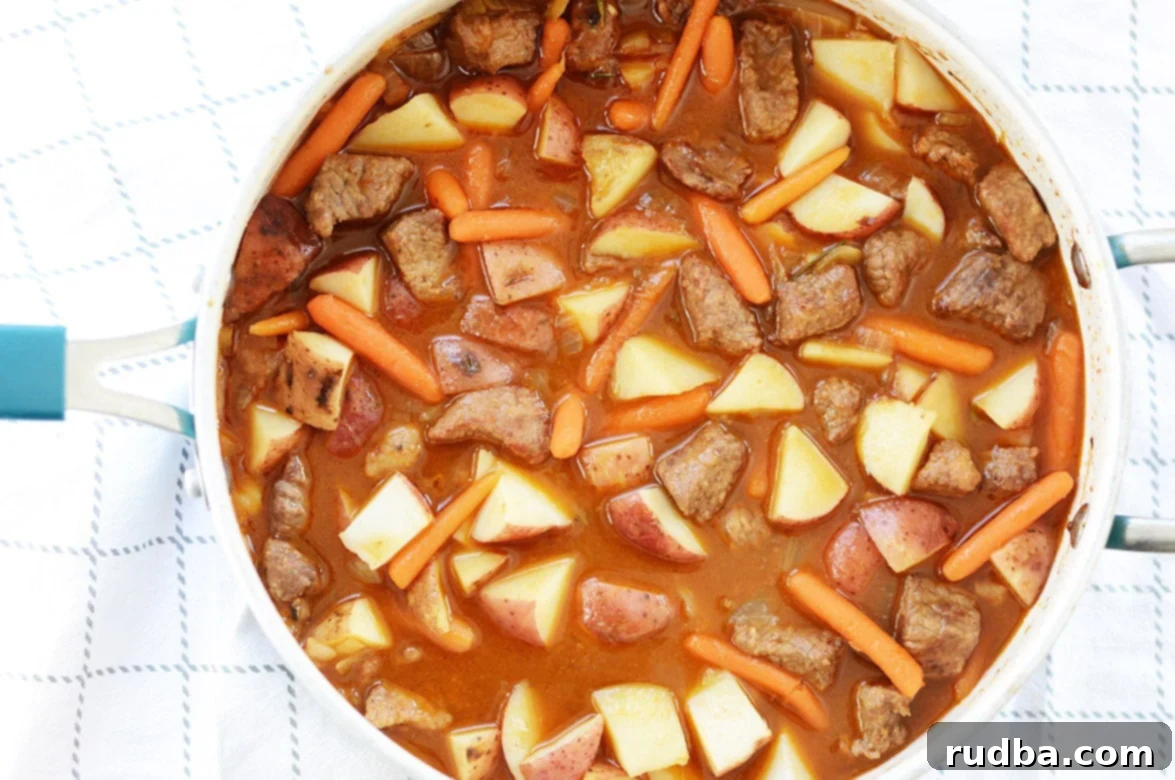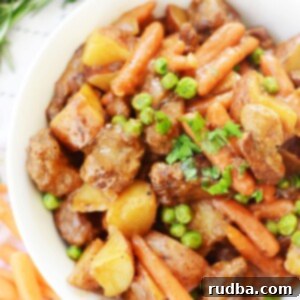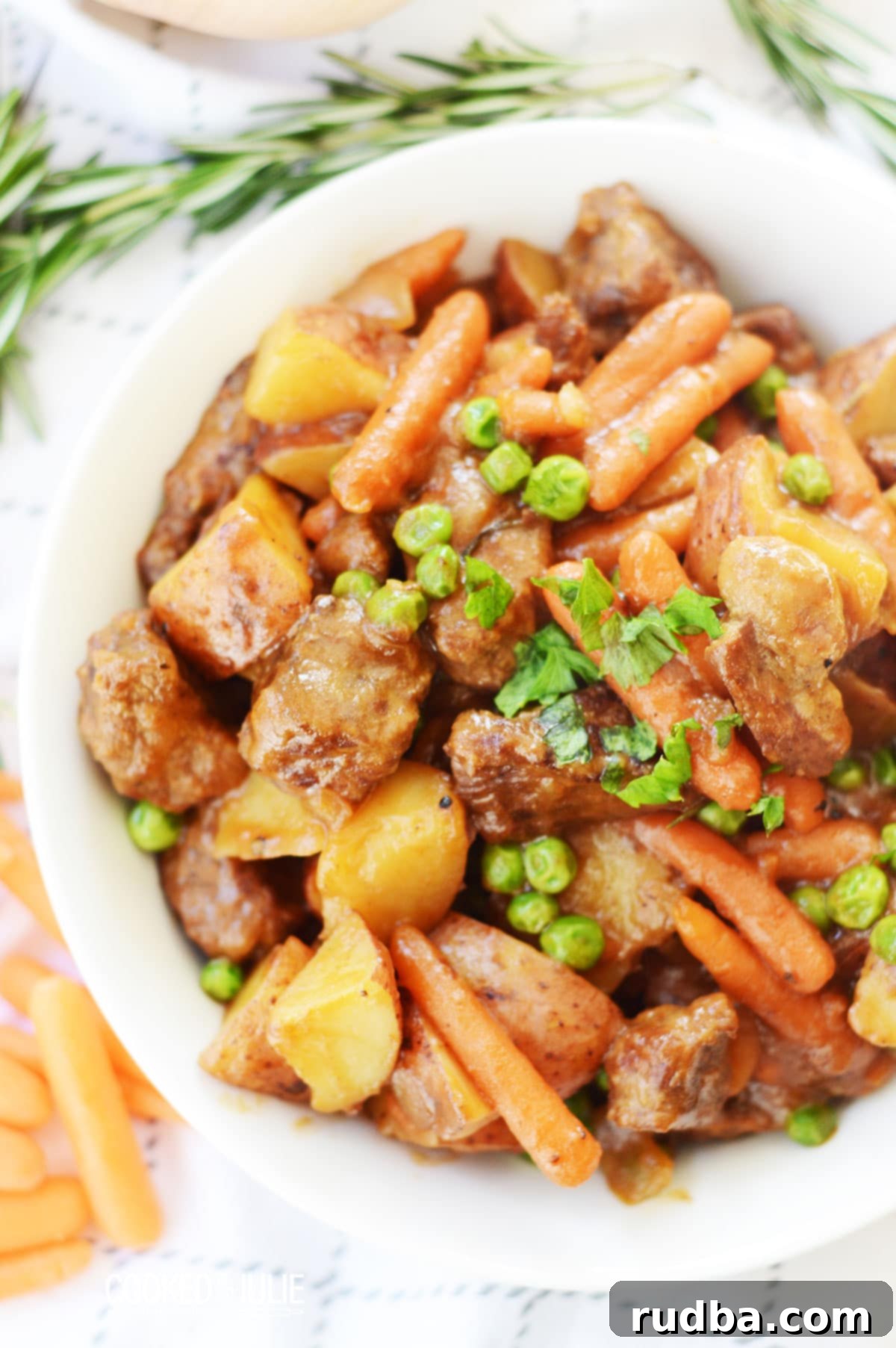Hearty & Easy Homemade Beef Stew: Your Ultimate Comfort Food Recipe
Dive into the rich, comforting embrace of a classic homemade beef stew. This recipe is not just fail-proof and incredibly easy to follow, but it also delivers an intensely delicious flavor that will warm you from the inside out. Perfect for chilly evenings or any time you crave a truly satisfying meal, this beef stew is a timeless favorite for good reason.
Pair this delectable stew with a side of creamy mashed potatoes, a crusty loaf of bread for soaking up every last drop of the rich sauce, or some garlic buttery rice. It’s a versatile dish that promises pure culinary bliss!

What Makes This Beef Stew So Special?
Beef stew is a hearty and deeply comforting dish renowned for its rich flavors and tender textures. Typically crafted with succulent cuts of beef, an assortment of robust vegetables, and a savory broth or stock, this dish truly shines when simmered slowly over time. This extended cooking process allows all the ingredients to meld together, creating a profoundly flavorful and meltingly tender meal that is absolutely perfect for cold weather, family gatherings, or simply when you need a satisfying and wholesome dinner.
If you’re a fan of comforting beef dishes, you might also enjoy our sweet potato beef stew for a touch of sweetness, these quick garlic butter steak tips, or a delightful pan of beef and shells.
Ingredient Notes for a Flavorful Beef Stew
The secret to an exceptional beef stew lies in selecting the right ingredients. Here’s a detailed look at what you’ll need and why each component is crucial to achieving that perfect depth of flavor and tender consistency. Remember, FOR SPECIFIC INGREDIENT QUANTITIES AND STEP-BY-STEP INSTRUCTIONS, PLEASE REFER TO THE RECIPE CARD BELOW.
- Beef – The absolute best cut for beef stew is beef chuck roast. This cut is celebrated for its generous marbling (interspersed fat), which renders down beautifully during long, slow cooking, resulting in incredibly juicy and tender meat. It’s crucial to avoid lean cuts of beef, as they simply won’t achieve the desired tenderness and can become dry and tough, no matter how long they’re cooked. Don’t trim away all the fat from your chuck roast; it’s a key flavor enhancer!
- Flour – All-purpose flour plays a dual role in this recipe. Firstly, it coats the beef before searing, helping to create a beautiful crust and deepening the flavor through the Maillard reaction. Secondly, it acts as a primary thickening agent for the stew’s rich sauce, ensuring a luscious, comforting consistency.
- Onion – Onions are fundamental to building the flavor base of any good stew. While white or yellow onions are ideal for their balanced sweetness and pungency, a red onion can also be used, offering a slightly sharper flavor. Dice them finely to ensure they meld seamlessly into the sauce.
- Garlic – Fresh garlic is non-negotiable for the best results. Its aromatic qualities are essential for a robust flavor profile. Minced garlic infuses the stew with a warm, pungent depth that dried garlic simply cannot replicate.
- Carrots – Carrots add natural sweetness, color, and texture to the stew. Any type of carrot will work beautifully, whether you use standard carrots peeled and chunked, or baby carrots for convenience. Their sweetness complements the savory notes of the beef perfectly.
- Potatoes – Potatoes are a classic stew ingredient, providing a satisfying bulk and absorbing the delicious flavors of the broth. I personally love using yellow baby potatoes for their creamy texture and quick cooking time, but feel free to use any waxy potato you have on hand, such as Yukon Gold or even small red potatoes. Just ensure they are cut into uniform pieces for even cooking.
- Thyme and Rosemary – These fresh herbs are powerhouses of flavor for beef stew. Their earthy, aromatic notes penetrate the meat and vegetables during the long simmer, creating a complex and inviting aroma. While dried herbs can be used in a pinch, fresh sprigs offer a far superior, brighter flavor.
- Red Wine – (Optional, but highly recommended) A dry red wine like Cabernet Sauvignon is recommended. Avoid sweeter or fruitier wines, as they can alter the savory balance of the stew. Red wine adds incredible depth, acidity, and a nuanced layer of flavor by deglazing the pan and dissolving all those delicious browned bits from the beef.
- Beef Stock – High-quality low-sodium beef stock is the backbone of the stew’s liquid base, providing a rich, savory foundation. If beef stock isn’t available, water can be used as a substitute, but be prepared to adjust seasonings to compensate for the reduced depth of flavor.
- Red Pepper Flakes – (Optional) For those who enjoy a subtle kick, a pinch of red pepper flakes adds a gentle warmth and a hint of spice, elevating the overall flavor profile without making the stew overly hot.
- Sugar – A small amount of sugar helps to balance the acidity from the tomato paste and red wine, enhancing the savory notes and bringing out the natural sweetness of the carrots and onions.
- Tomato Paste – This concentrated tomato product adds a rich, umami depth and a touch of acidity, contributing to the stew’s deep color and robust flavor. It’s a small but mighty ingredient.
- Worcestershire Sauce – Just a tablespoon of Worcestershire sauce provides an incredible boost of savory, tangy, and slightly umami flavor, complementing the beef and other ingredients beautifully.
- Bay Leaf – A single bay leaf slowly infuses the stew with a subtle, aromatic herbal note, contributing to its complex flavor profile. Remember to remove it before serving.
- Peas – Fresh or frozen peas are added at the very end to provide a pop of color, a hint of sweetness, and a tender texture. They cook very quickly, so adding them too early will result in mushy peas.
- Oil – A neutral cooking oil with a high smoke point, such as vegetable, canola, or grapeseed oil, is essential for searing the beef and sautéing the aromatics.
- Salt and Pepper – These fundamental seasonings are crucial for bringing all the flavors together. Season generously at multiple stages to build layers of taste.

Top Tips for an Unforgettable Beef Stew
Creating a truly magnificent beef stew is an art, but with these expert tips, you’ll achieve perfection every time. These simple techniques will elevate your stew from good to absolutely extraordinary.
- Timing is Everything for Vegetables: To prevent your carrots and potatoes from turning into mush while your beef is still tenderizing, add them later in the cooking process. Incorporate them only after the beef has had a good head start and is beginning to soften. This ensures they cook to a perfect, fork-tender consistency without overcooking.
- Achieving the Perfect Stew Thickness: While the flour coating on the beef will certainly help thicken the sauce, you have additional options if you prefer a richer, thicker consistency. You can cook the beef stew uncovered for the last 30-60 minutes to allow some liquid to evaporate, naturally reducing and thickening the sauce. Alternatively, a cornstarch slurry is your best friend: simply mix equal parts water and cornstarch (start with 1 teaspoon of cornstarch mixed with 1 teaspoon of cold water) and stir it into the simmering stew until it reaches your desired thickness.
- Prepare Your Beef for Even Cooking: For the best results, take your beef out of the refrigerator at least 30 minutes before you plan to cook it. Allowing it to come closer to room temperature ensures more even cooking. Additionally, it’s vital to pat the beef dry thoroughly with paper towels before seasoning. Excess moisture will steam the meat rather than sear it, preventing that crucial flavorful crust from forming. A dry surface allows salt and pepper to adhere better and promotes superior browning.
- The Power of Browning the Meat: This step is arguably the most important for developing deep, complex flavors in your stew! Searing the beef in hot oil creates a beautiful, caramelized crust on the exterior through the Maillard reaction. This not only locks in the juices, keeping the meat incredibly tender, but also develops a profound depth of savory flavor that forms the foundation of your entire stew. Don’t overcrowd the pot; sear the beef in batches to ensure good browning.
- Adjusting Sauce Consistency: If you find your stew sauce has thickened too much during cooking, don’t fret! Simply add a little bit of extra water or beef stock, a quarter cup at a time, stirring well after each addition until you reach your preferred consistency.
- Final Seasoning Check: Always taste your stew and adjust the seasoning with salt and pepper right before serving. Flavors can mellow or intensify during the long cooking process, so a final check ensures your stew is perfectly balanced and utterly delicious.
- Don’t Forget to Deglaze: After browning the beef and sautéing the onions, you’ll notice delicious browned bits (fond) stuck to the bottom of your pot. When you add the red wine or beef stock, scrape these bits up with a wooden spoon. This process, called deglazing, incorporates all those caramelized flavors back into the sauce, adding incredible richness and depth.

How to Achieve Perfectly Tender Beef Stew?
The key to melt-in-your-mouth beef stew lies in the “low and slow” cooking method. To achieve truly tender beef, the stew should be cooked at a consistently low temperature, ideally covered, for an extended period. This gentle heat allows the tough connective tissues in cuts like chuck roast to gradually break down and collagen to convert into gelatin, resulting in incredibly succulent and tender meat that practically falls apart.
While the recipe calls for a specific cooking time, generally, cooking beef stew for approximately 2 hours (or even longer, depending on the cut and heat) will yield the most delicious and wonderfully tender beef. Patience is a virtue when it comes to beef stew; don’t rush the process, and you’ll be rewarded with an unforgettable dish.

Serving Suggestions for Your Hearty Stew
While this beef stew is a complete meal on its own, pairing it with the right side dishes can elevate the experience. Here are some fantastic serving suggestions to round out your comforting meal:
- Creamy Mashed Potatoes: A classic pairing, the smooth and buttery mashed potatoes are perfect for soaking up the rich, savory gravy.
- Crusty Bread or Dinner Rolls: Essential for dipping into the flavorful broth and ensuring no drop goes to waste. A warm baguette or a rustic sourdough loaf would be ideal.
- Garlic Buttery Rice: For a different texture, serve your stew over a bed of fragrant garlic-infused rice.
- Polenta: Creamy polenta offers a delightful Italian-inspired twist and a wonderful base for the stew.
- Egg Noodles: Simple, broad egg noodles can be tossed with a little butter and served alongside or underneath the stew.
- Green Salad: A light, fresh green salad with a vinaigrette dressing can provide a lovely contrast to the richness of the stew.
- Roasted Vegetables: If you want more veggies, consider serving with a side of roasted asparagus or green beans.
Storage and Reheating Instructions
Beef stew often tastes even better the next day, as the flavors have more time to meld and deepen. Proper storage ensures you can enjoy your leftovers safely and deliciously.
- Refrigeration: Allow any leftover beef stew to cool completely at room temperature (no longer than two hours) before transferring it to an air-tight container. Refrigerate promptly for up to 3 days.
- Freezing: For longer storage, beef stew freezes beautifully. Once cooled, transfer the stew to freezer-safe containers or heavy-duty freezer bags, leaving about an inch of headspace. It can be stored in the freezer for up to 3 months. Thaw overnight in the refrigerator before reheating.
- Reheating:
- Stovetop: Transfer the stew to a pot or Dutch oven and reheat over medium-low heat, stirring occasionally, until it is warmed through. If it’s too thick, add a splash of beef stock or water.
- Microwave: For individual servings, place in a microwave-safe bowl, cover loosely, and heat in 1-2 minute intervals, stirring in between, until hot.
- Oven: For larger quantities, place in an oven-safe dish, cover with foil, and reheat at 325°F (160°C) for 20-30 minutes, or until thoroughly heated.
We hope you love this classic beef stew recipe! If you’ve tried it, please take a moment to leave a star ⭐️⭐️⭐️⭐️⭐️ rating in the recipe card below and/or share your thoughts in the comments section further down the page. Your feedback is greatly appreciated! And don’t forget to consider following me on Facebook or Pinterest for more delicious recipes!
Frequently Asked Questions About Beef Stew
Can I Make This Beef Stew in a Slow Cooker or Instant Pot?
Absolutely! This recipe adapts beautifully to both slow cookers and Instant Pots. For a slow cooker, follow the browning and sautéing steps on the stovetop, then transfer everything to the slow cooker and cook on low for 6-8 hours or high for 3-4 hours, adding vegetables in the last hour. For an Instant Pot, use the sauté function for browning and aromatics, then pressure cook on high for about 35-45 minutes with a natural release, adding vegetables after the first cooking cycle and pressure cooking again for 5-10 minutes.
What if I Don’t Drink Alcohol? Can I Skip the Red Wine?
Yes, the red wine is optional and can be skipped. If you prefer not to use wine, simply substitute it with an equal amount of additional low-sodium beef stock. While the wine adds a layer of depth and acidity, the stew will still be incredibly flavorful without it.
My Stew is Too Thin/Thick. How Can I Fix It?
If your stew is too thin, you can continue simmering it uncovered to allow more liquid to evaporate. Alternatively, create a cornstarch slurry (1 tablespoon cornstarch mixed with 1 tablespoon cold water) and stir it into the simmering stew until it reaches your desired thickness. If your stew is too thick, simply add a splash of beef stock or water, a quarter cup at a time, until you achieve the perfect consistency.
Can I Add Other Vegetables to This Stew?
Definitely! Beef stew is incredibly versatile. Feel free to add other root vegetables like parsnips or rutabagas, or even greens like kale or spinach (add these in the last 10-15 minutes of cooking). Mushrooms are also a fantastic addition, especially if sautéed with the onions for extra umami flavor.

Beef Stew
Julie Maestre
5 minutes
2 hours
2 hours 5 minutes
4
Save RecipeSaved Recipe
Pin Recipe
Rate Recipe
Print Recipe
Ingredients
- 2 lbs boneless beef chuck , cut into 1 ½ inch pieces
- ¼ cup all-purpose flour
- 1 large onion, diced
- 4 garlic cloves, finely minced
- ¼ teaspoon red pepper flakes, optional
- 1 teaspoon sugar
- 1 cup red wine , optional
- 5 cups low sodium beef stock
- 1 tbsp tomato paste
- ½ lb baby potatoes, sliced in half
- 2 carrots, peeled and cut into 1-inch chunks
- 1 tablespoon Worcestershire sauce
- 1 rosemary sprig
- 1 thyme sprig
- 1 bay leaf
- ⅓ cup peas, frozen or fresh
- 3 tablespoons oil, or more if needed
- salt and pepper to taste
Prevent your screen from going dark
Instructions
-
Cut the beef into 1 ½ inch pieces, pat dry thoroughly with a paper towel to remove excess moisture, and season generously on all sides with salt and freshly ground black pepper. Evenly coat the beef with ¼ cup of all-purpose flour, shaking off any excess.
-
Heat the oil in a large, heavy-bottomed pot or Dutch oven over medium-high heat until shimmering. Add the floured beef in batches (do not overcrowd the pot) and cook for 3-4 minutes on each side until beautifully browned and a rich crust forms. Remove the browned beef from the skillet and set it aside.
-
Add the diced onions to the same pot, reducing the heat to medium-low. Add a little more oil if needed. Cook the onions for 3-4 minutes, stirring frequently, until they soften and become translucent, scraping up any browned bits from the bottom of the pot.
-
Stir in the finely minced garlic, red pepper flakes (if using), and tomato paste. Cook for another minute, stirring constantly, until fragrant. Season with a pinch of salt and pepper.
-
Pour in the red wine (if using), scraping the bottom of the pot with a wooden spoon to deglaze and incorporate all the flavorful fond. Add the beef stock, rosemary sprig, thyme sprig, bay leaf, and Worcestershire sauce. Return the browned beef back into the skillet. Bring the liquid to a gentle boil. Once boiling, reduce the heat to medium-low, cover the pot tightly, and simmer for 1 hour and 30 minutes, or until the beef begins to tenderize.
-
If the sauce thickens too much during this stage, add a little bit of water or beef stock. Now, add the chopped carrots and potatoes to the pot. Cover again and continue to cook for another 25 minutes, or until the carrots and potatoes are perfectly fork-tender and the beef is incredibly soft and succulent.
-
Stir in the peas, remove the rosemary, thyme, and bay leaf sprigs. Taste the stew and season generously with additional salt and pepper as needed. Simmer uncovered for 3-4 minutes to allow the flavors to marry, then serve hot and enjoy your homemade, comforting beef stew!
Nutrition
Nutrition information is automatically calculated, so should only be used as an approximation.
Additional Info
Julie Maestre
5 minutes
2 hours
2 hours 5 minutes
Entree
American
4
677
beef stew, classic beef stew, Easy Beef Stew, homemade beef stew, comfort food
Like this recipe? Leave a comment below!
